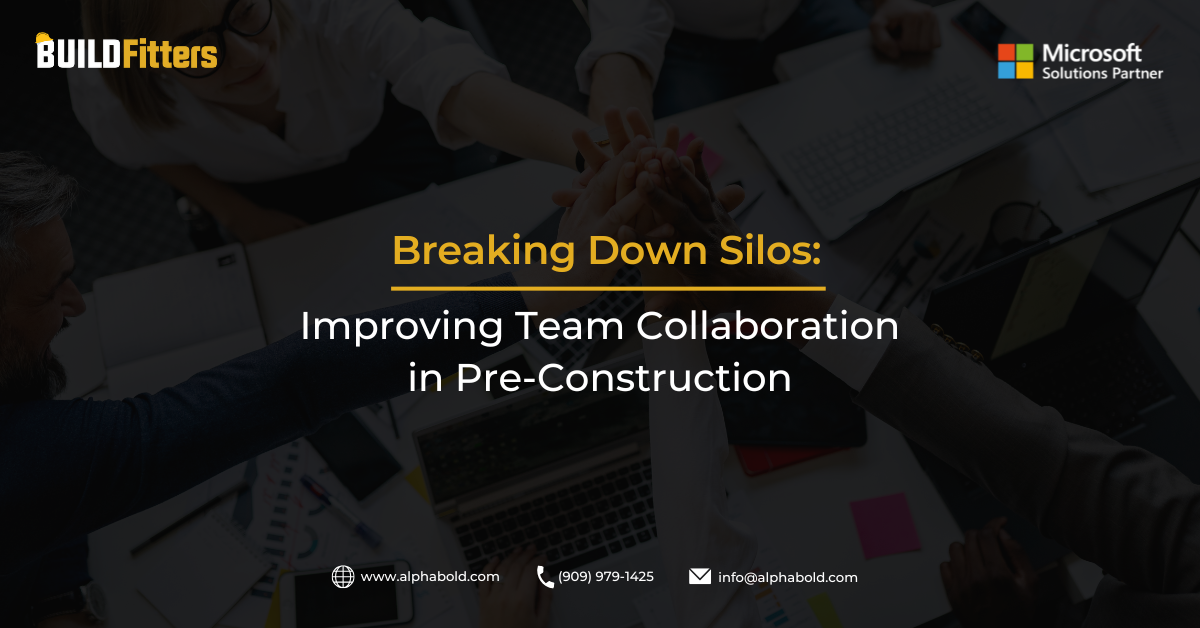
Breaking Down Silos: Improving Team Collaboration in Pre-Construction
Introduction
Pre-construction is no longer confined to conventional linear design, bid, and build approaches. With time, it’s evolving into a dynamic, iterative process that demands trust, transparency, and adaptability. In fast-paced construction projects, pre-construction and construction processes often overlap, complicating bidding, estimating, design management, and Building Information Modeling (BIM) coordination. Yet, many firms remain tethered to outdated, manual methods relating to email, paper trails, and fragmented software—which contribute to communication gaps, inaccurate estimates, disorganized documentation, and delays. In this blog, we’ll explore how breaking down silos and leveraging the right pre-construction collaboration tools can transform pre-construction into a seamless and efficient process. Organizations can bag lucrative opportunities by overcoming traditional barriers, ensuring better communication, and setting their construction teams up for success.
The urgency for improvement is clear. According to FMI’s State of Global Pre-construction report, fewer than one in five firms excel in pre-construction performance with dedicated staff and standardized practices. This gap highlights the pressing need for innovative solutions to enhance predictability, efficiency, and profitability in pre-construction processes. Effective pre-construction collaboration tools can address these pain points, offering a structured approach to navigating complexities and fostering better outcomes.
Pre-construction Challenges: The Need for Tackling the Root-cause
In pre-construction, relying on manual and disconnected solutions creates significant challenges that disrupt project success. These issues affect communication, estimation accuracy, documentation practices, data transfer, and overall process efficiency. The lack of centralized and automated systems amplifies inefficiencies, leading to delays, errors, and rework that increase costs and jeopardize stakeholder trust. Below mentioned are the in-depth challenges faced in pre-construction:
1. Communication Breakdown:
- Scattered Information: Vital project information is often spread across disconnected channels such as email, phone, paper, and siloed technologies, making it difficult to retrieve and share efficiently.
- Delays and Misunderstandings: Fragmented communication leads to delays in decision-making, misunderstandings among teams, and disputes that escalate project risks.
- Erosion of Stakeholder Trust: When stakeholders receive inconsistent updates or unclear information, their confidence in project management diminishes, impacting relationships and future collaborations.
Explore BUILDFitters Pre-construction App
Manage your pre/post-construction, roofing, AEC, mechanical, HVAC, materials and services business with BUILDFitters!
Request a Demo2. Inaccurate Estimation Processes:
- Manual Methods: Reliance on spreadsheets and manual tools increases the probability of human error and inaccurate calculations.
- Project Overlaps: Estimators managing multiple projects find it challenging to meet deadlines due to the limitations of manual systems.
- Cost Implications: Inaccurate estimates can lead to cost overruns, bid loss, and strained client relationships when expectations are unmet.
3. Outdated Documentation Practices:
- Limited Visibility: Outdated documentation systems hinder real-time tracking and prevent project teams from accessing the latest information.
- Frequent Changes: As project details change frequently, stakeholders like specialty contractors often remain unaware, leading to alignment issues and operational disruptions.
- Legal and Contractual Risks: Misaligned documentation increases the likelihood of legal disputes and contractual breaches, affecting project timelines and costs.
4. Inefficient Handoffs:
- Data Transfer Gaps: Fragmented systems often slow the transition from pre-construction to construction, causing critical data to be missed or delayed.
- Manual Effort: Handoffs rely heavily on manual processes, increasing inefficiencies and errors that affect project continuity and planning.
5. Lack of Process Automation:
- Rework Costs: Manual processes cause rework, accounting for 19% of total project costs, unnecessarily consuming time and resources.
- Data Entry Errors: Heavy reliance on manual data entry introduces inaccuracies that cascade into subsequent project phases.
- Productivity Loss: The absence of automation slows down workflows, reducing overall productivity and increasing operational costs.
6. Challenges in BIM and Design Coordination:
- Centralization Issues: Design coordination is fragmented without centralized systems, causing bottlenecks and inefficiencies in project execution.
- Error Propagation: Misalignments in building Information Modeling (BIM) data can lead to construction errors and rework.
- Team Morale and Delays: Lengthy project backlogs frustrate team members, delay project kickoff, and jeopardize client satisfaction due to unmet deadlines and expectations.
7. Overall Impact on Stakeholders and Projects:
- Early Risks: Inefficiencies and errors in the pre-construction phase introduce risks that negatively affect project outcomes and competitiveness in securing bids.
- Client Dissatisfaction: Delays, rework, and misaligned expectations can harm client relationships and affect future business opportunities.
- Morale Impact: Teams dealing with repeated challenges experience frustration and decreased motivation, affecting overall productivity.
The Solution: Leveraging Pre-construction Collaboration Tools
Investing in advanced pre-construction tools isn’t just a smart move—it’s essential for driving collaboration and ensuring the best project outcomes. These tools offer a centralized platform that eliminates silos, empowering teams to communicate in real-time and work together seamlessly, no matter where they are. By connecting all project stakeholders and providing a single, trusted source of truth, pre-construction collaboration tools keep everyone aligned, minimize communication gaps, and streamline workflows like never before.
From a technical perspective, these tools are more than just software—they’re the backbone of a cohesive, efficient project environment. The leading pre-construction collaboration tools mentioned below offer an in-depth look at their benefits, use cases, and unique features. I’ve also highlighted each tool’s value proposition and USP, backed by credible sources that validate their industry recognition and real-world impact.
Manage the Pre-construction Phase of Your Project with Ease
Leverage BUILDFitters for end-to-end construction operations. Request a demo today to see how BUILDFitters can streamline your project from start to finish.
Request a DemoAutodesk Construction Cloud:
Overview:
Autodesk Construction Cloud integrates advanced design coordination, BIM capabilities, and real-time collaboration into a unified platform. Combining cloud-based accessibility with powerful project management tools, it enables stakeholders to streamline workflows and achieve greater transparency. This platform is ideal for handling complex projects that demand continuous communication and precise execution.
Attributes and Use Cases:
The platform’s cloud infrastructure provides real-time updates, ensuring team members always have access to the latest project data. Advanced BIM integration supports design coordination by detecting and resolving potential clashes early. Its robust document management capabilities enhance accountability and reduce delays. Autodesk Construction Cloud is particularly well-suited for architects and engineers working on intricate designs and construction managers overseeing projects requiring extensive documentation. Key use cases include large-scale design-build projects, collaborative workflows between design and construction teams, and managing revisions across multiple stakeholders.
Bluebeam Revu:
Overview:
Bluebeam Revu specializes in document-centric workflows, offering precision tools for PDF editing, markup, and collaboration. Known for its focus on construction documentation, Bluebeam streamlines plan reviews and ensures project stakeholders remain aligned. The tool’s efficiency in managing documentation has made it a staple in construction planning and review processes.
Attributes and Use Cases:
Bluebeam Revu’s standout features include Studio Sessions for real-time document collaboration and advanced markup tools for accurate annotations. These features enable teams to review, edit, and approve documents without delays, improving accuracy and accountability. Bluebeam’s capabilities make it valuable for detailed plan reviews and collaborative approval workflows. Use cases include ensuring document accuracy for complex projects, managing revisions efficiently, and facilitating communication between remote teams.
PlanGrid:
Overview:
PlanGrid, part of Autodesk Construction Cloud, is a mobile-first solution designed to improve on-site collaboration and accountability. With features that bridge the gap between office and field operations, PlanGrid ensures teams always have access to the latest project data, reducing miscommunication and delays.
Attributes and Use Cases:
PlanGrid excels at providing real-time updates to plans, documents, and field reports. It enables issue tracking directly from the job site, improving on-site accountability and facilitating swift problem resolution. Its mobile access and real-time data synchronization are particularly useful for field teams that need updated plans on demand. Use cases include managing on-site activities, coordinating field and office operations, and ensuring compliance with up-to-date project specifications.
BIM 360Overview:
Overview:
BIM 360, another solution within Autodesk Construction Cloud, enhances design coordination and collaboration through BIM technology. It integrates project data into a centralized system, reducing errors and improving efficiency during the pre-construction phase. This tool is designed for teams handling complex design-build projects requiring high levels of precision and collaboration.
Attributes and Use Cases:
BIM 360 offers centralized access to BIM models, supports clash detection, and enables constructability reviews, ensuring the accuracy of project designs. By facilitating early conflict resolution, it reduces risks and streamlines pre-construction planning. Its capabilities are especially beneficial for design-build teams managing intricate MEP systems and large-scale projects requiring detailed coordination. Use cases include improving design accuracy, integrating workflows for diverse teams, and addressing potential construction conflicts early.
BUILDFitters
Overview:
BUILDFitters transforms the pre-construction phase into a seamless, efficient, and precise process. Its cloud-based platform centralizes all pre-construction activities, from estimating to bid creation, ensuring that teams remain aligned and empowered. With BUILDFitters, no more scattered documents, misaligned data, and manual inefficiencies. This innovative solution integrates sales, pre-construction, and post-construction workflows into a unified ecosystem, setting the stage for unparalleled project success.
See firsthand how BUILDFitters can help you manage proposals, award the right bids, and stay ahead of competition.
Attributes:
BUILDFitters excels in the pre-construction phase by addressing critical challenges and delivering tangible value:
- Cloud-Based Estimating: BUILDFitters allows estimators to create, adjust, and manage estimates from anywhere. This feature enhances productivity and ensures estimates are always accurate and up to date.
- Automated Bid Creation: By automating bid generation, BUILDFitters reduces manual errors and accelerates bid-to-contract workflows. Teams can save time and redirect focus to more strategic tasks.

- Centralized Document Management: BUILDFitters ensures that all pre-construction documents are stored, shared, and updated in one location. This eliminates version control issues and fosters effective collaboration across teams.
- Risk Management Tools: BUILDFitters equips project teams with the ability to assess and mitigate risks proactively. Its tools safeguard budgets and schedules, minimizing project vulnerabilities.
- Seamless Integration Across Phases: The platform connects sales, pre-construction, and post-construction phases, ensuring continuity and reducing miscommunication during project transitions.
Bonus read: How BUILDFitters Simplifies Pre-Construction with Construction Estimation Software.
Use Cases:
- For Contractors: BUILDFitters enables general contractors to manage multiple bids simultaneously, improving accuracy and reducing the time required to transition from pre-construction to execution.
- For Estimators: Teams benefit from cloud-based estimating, which streamlines collaboration and ensures precision in calculations.
- For Project Managers: BUILDFitters helps ensure that project documents and bids are aligned, minimizing disruptions and keeping schedules on track.
Why BUILDFitters?
- BUILDFitters doesn’t just optimize the pre-construction phase—it integrates it into the entire lifecycle of a construction project.
- The platform’s focus on automation, risk management, and centralization makes it a critical tool for teams aiming to stay competitive and efficient.
- By ensuring continuity across all project phases, BUILDFitters provides a clear edge in an industry where efficiency is non-negotiable.
Fast-Track Pre-Construction Process with BUILDFitters
BUILDFitters redefines what’s possible in pre-construction, making it the choice for forward-thinking decision-makers.
Request a DemoConclusion
Preconstruction has long been a challenging phase, often plagued by inefficiencies and fragmented workflows. But with the right tools, construction teams can now break free from these limitations. Organizations can streamline communication, enhance estimating accuracy, improve bid management, and foster better alignment across all teams by adopting advanced pre-construction collaboration tools. BUILDFitters offers a powerful solution that centralizes all pre-construction activities, ensuring smoother transitions, more precise estimates, and reduced risks. With BUILDFitters, construction firms can break down silos, improve collaboration, and move from planning to execution with confidence, setting the stage for successful projects every time.




